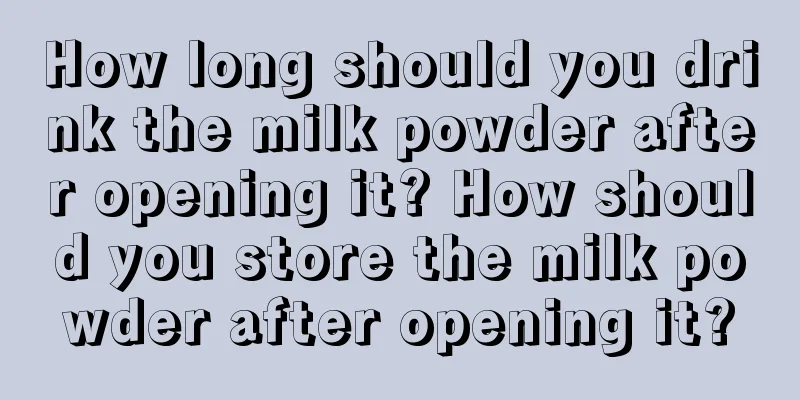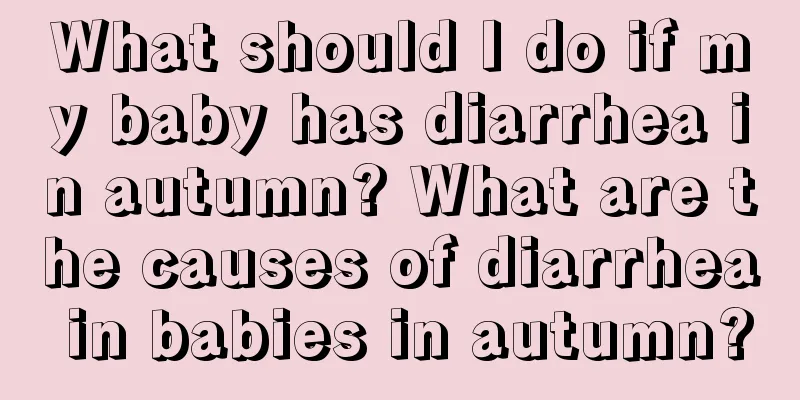What diseases should babies prevent in spring? Four popular spring diseases

|
As winter slowly passes, everything begins to revive, the weather becomes warmer, and bacteria begin to become prevalent in spring. The most common epidemics are influenza, croup, acute bronchitis and gastroenteritis. We should pay more attention to babies during this period. We should wash our hands frequently and keep warm. Let’s take a look at what diseases babies should prevent in spring! Spring disease No. 1 → Influenza*Causes/infection routes Influenza is one of the most common diseases. Its peak season is generally from December to March. It is mainly transmitted through droplets such as coughing and sneezing. The source of infection for children under 2 years old is usually their parents or family members living together. As long as someone in the family has influenza, the child will often be infected. Babies who have not been vaccinated have a higher chance of being infected. *symptom The biggest difference between influenza and common cold is that the symptoms of influenza, such as fever, headache, sore throat, and muscle aches, are particularly severe. In addition to intermittent coughing and runny nose, babies with influenza may also have vomiting and diarrhea. Liu Fangqing, director of the Department of Pediatrics at Dali Ren'ai Hospital, said that the most typical symptom of influenza is high fever (over 39 degrees), usually with chills and purple lips in the early stage, and coughing and runny nose will not start until the second day. So when a child's fever exceeds 39 degrees, and the body temperature rises instead of dropping after taking antipyretics, even if other cold symptoms have not appeared, it is very likely to be influenza. Since the symptoms of influenza are most severe in the first 2 or 3 days, children usually have weakness in their limbs and body aches, and some people even feel so painful that they cannot walk. Therefore, if a child returns home from an outing and has symptoms such as poor spirits, red throat, and high fever, be alert that it may be influenza. Treatment Doctors usually prescribe cold medicines such as antipyretics based on symptomatic treatment. In severe cases, antiviral drugs (Tamiflu or Relenza) will be used in combination. Children's fever will usually subside within 2 to 3 days after taking the medicine. * Nursing principles When the child starts to have a fever of about 39 degrees, give him antipyretics first, observe the temperature changes after half an hour, and when the temperature drops below 38 degrees, you can let the child take a warm bath to help sweat, so that he will be more comfortable. If the child shows symptoms of shivering and cold hands and feet at the beginning, you should add clothes or wrap him in a quilt to ensure the body is warm. Wait until the child starts to sweat after taking the antipyretics, and then take off the covering clothes one by one. Since most people with influenza will have difficulty swallowing and even diarrhea, it is best to eat light food. At the same time, children must drink enough water. Electrolyzed water, sports drinks or fruit juice are all good sources. In order to prevent children from being infected again, parents or primary caregivers must wash their hands thoroughly after cleaning the baby's oral and nasal secretions. They must also wear masks when going out and wash their hands before leaving public places. Given that a small number of influenza patients may develop encephalitis, pneumonia or myocarditis, mothers should pay special attention to their babies' behavior after the fever subsides. Generally speaking, the baby will be back to normal after the third day of fever subsidence, with sputum in the cough but no wheezing. If the baby continues to have a fever for more than three days after taking antiviral drugs, and has symptoms of poor activity, shortness of breath, and increasingly severe coughing, it is best to see a doctor immediately. To avoid heat cramps, you should take off your clothes appropriately. During a fever, when the child starts to sweat and the fever subsides, be sure to help him take off the clothes or quilts that he had added previously, so as to prevent the body temperature from being unable to drop effectively, which may cause a small number of children with a heat cramp constitution to develop an illness. *Tips Director Liu Fangqing said that many parents worry about the side effects of influenza vaccines for their children, but according to statistics, only about one in a few million children will have severe allergies after vaccination, and very few will have Parents don’t need to worry too much about cold symptoms. In addition, many parents are afraid that vaccines may induce allergic reactions. Director Liu Fangqing said that if the child is under 1 year old or rarely comes into contact with egg dishes, he or she can stay in the hospital for half an hour after the vaccination to make sure that there are no allergic symptoms before leaving the hospital. She emphasized that because influenza is a viral infection, the best way to prevent it is to wash hands frequently, wear a mask and take the vaccine. If you do not want your child to be vaccinated, the primary caregiver and other family members living with you must vaccinate themselves to avoid indirectly transmitting the flu virus to the baby. Ask: How to tell if your baby has an allergy or a cold? Children with allergic constitutions mainly experience local symptoms such as nasal congestion, runny nose, sneezing, coughing, and sore throat, while children with influenza will experience systemic symptoms such as headache, high fever, and muscle aches. Spring disease No. 2 → Croup*Causes/infection routes Croup is also one of the common diseases in spring. It is mainly transmitted through droplets. This parainfluenza virus can cause swelling and inflammation of the epiglottis cartilage in the upper respiratory tract. In the most serious cases, it may block the trachea and cause suffocation due to lack of oxygen. This is especially true for children aged 6 months to 2 years old. Because the bronchi are not yet fully developed, once infected, they will become severely inflamed and swollen. Parents should pay more attention. *symptom Croup usually occurs in the middle of the night and is often accompanied by a fever. Children usually suddenly have a fever of around 39-40 degrees and begin to make a sound similar to a dog barking and rapid breathing. They will also keep crying and coughing. The crying is often hoarse or even silent. At this time, the cartilage below the neck can be found to be sunken and showing obvious ups and downs. Director Liu Fangqing reminded that since croup may cause respiratory distress and spasms, once the child's respiratory rate rises to 50-60 times per minute (normal respiratory rate is 30 times per minute), and the chest is sunken when breathing, and the child cries and gasps, and has purple lips, difficulty swallowing, and drooling, it is best to send the child to the emergency room immediately. Treatment If this acute symptom is not treated immediately, it will not only cause hypoxia, but may even cause severe respiratory spasm. Therefore, when a child has similar symptoms, he must seek medical treatment immediately. The doctor will generally give Inhaled bronchial detumescent drugs are given, and steroids are used as appropriate, with steam used to reduce the swelling of the respiratory tract. Director Liu Fangqing said that since children often cry and scream when they are uncomfortable during consultation, the more they cry, the more swollen their respiratory tract will become. Parents must be mentally prepared to comfort their children to prevent the symptoms from worsening. * Nursing principles In addition to letting children take cough and phlegm medicine on time, water vapor can also be used to reduce the viscosity of the respiratory tract. Parents may wish to take their babies to the bathroom to breathe hot water vapor. Those who have a steam machine at home can use medicine with spray treatment, which will help the baby recover faster. In terms of diet, the principle of small and frequent meals should be followed, with semi-liquid foods such as steamed eggs, tofu pudding, and pudding as the main foods. Avoid foods that are too hot, too hard, or too spicy, and let children drink more water. In addition, in order to prevent children from being restless and worsening symptoms, the home must be kept quiet. *Tips Since children under 2 years old often like to put small snacks or toys such as peanuts and melon seeds into their mouths, when a child breathes rapidly and makes heavy wheezing sounds, it may also be caused by foreign body infarction. In view of the fact that foreign body inhalation will still cause wheezing even after taking anti-edema drugs, in order to avoid delaying treatment, when the baby has respiratory symptoms, it is best to fully record the current situation and actively inform the doctor when seeing a doctor to facilitate differential diagnosis. Ask: How to tell whether your baby has croup or asthma? The inflamed part of croup is the large bronchi below the epiglottis cartilage, so it will produce a rougher breathing sound similar to a barking dog. The inflamed part of asthma is the small bronchi close to the lungs, so the breathing sound will be thinner, usually a "whoosh" sound. Spring disease No. 3 → Acute bronchitis*Causes/infection routes Acute bronchitis is common in spring and winter, with respiratory syncytial virus being the most common. It is mainly transmitted through droplets, and babies aged 3 months to 2 years old are at high risk. Unlike asthma, which is an inflammation of the upper respiratory tract, acute bronchitis is an inflammation of the lower respiratory tract, but it can also cause bronchial swelling, coughing and wheezing. Director Liu Fangqing said that since asthma monitoring can only be done for children over 3 years old, if a baby has wheezing but is under 3 years old, it is usually classified as acute bronchitis unless it recurs more than 3 times in a year. She explained that if a baby under 3 years old has repeated wheezing, it may be "infantile asthma". This type of asthma mostly occurs in premature babies or babies with chronic lung diseases, and the cause is mostly immature trachea or congenital problems. *symptom Children with acute bronchitis may not have a fever, but they will secrete a lot of phlegm in a short period of time. At this time, the child will breathe rapidly, cough repeatedly, and spit out a lot of white sticky phlegm, especially in the middle of the night, and will have a wheezing sound similar to asthma, and will have a loss of appetite. It is possible that the child will vomit while drinking milk. Remind mothers that if the child coughs up phlegm frequently, breathes rapidly, and the lower edge of the ribs is sunken, it may be acute bronchitis, and it is best to seek medical treatment immediately. Treatment Since infants and young children do not have enough strength to cough up phlegm, if there is no fever or bacterial infection (the phlegm is yellow), doctors will generally use expectorants and give expectorant drugs (used in steam machines) to expand the baby's bronchi and expel phlegm. At this time, you can also take your child to the bathroom to breathe hot water steam. As long as you take medicine regularly, clear the phlegm and use steam therapy, the symptoms will generally improve in 3 to 5 days. * Nursing principles Since bronchitis does not necessarily cause fever, most children can still run around energetically, but because excessive activity will aggravate the symptoms of "wheezing", it is best to let children focus on static activities. In addition, if the child secretes a lot of sputum, the diet should be small and frequent, and cough spray should be used to assist in clearing the sputum. When clearing the sputum, it is best to place the baby on the thigh with the head low and the feet high, and cup the palms to pat, try to avoid the spine, and aim at the position of the shoulder blades on both sides. *Tips Although the main source of infection of acute bronchitis is virus, the bronchi of infants and young children are also susceptible to allergens such as dust, dust mites, and pollen before they mature, which can cause acute inflammation. It is best to remove carpets, thick curtains, plush toys and other possible allergens in the home environment, and use anti-mite antibacterial laundry detergent. Indoor humidity should be controlled at 50% to 70%. Dehumidifiers and air purifiers should be used during the rainy season. If the suspended particulate matter in the air is too high, you must wear a mask for your baby when going out. On the other hand, Director Liu Fangqing said that many parents think that bronchitis will develop into asthma, but this occasional viral infection does not actually cause asthma. As long as you do a good job of environmental control and prevent the breeding of allergens, you don't have to worry about your baby suffering from asthma. Spring disease No. 4 → Epidemic gastroenteritis*Causes/infection routes The main causes of epidemic gastroenteritis in spring are norovirus and rotavirus. For norovirus, the epidemic period is generally from November to March or April of the following year. The infected groups are of all ages. The main transmission medium is oral secretions and vomitus. Once you come into contact with the patient's respiratory secretions, eat food contaminated by the virus, or touch utensils contaminated by the virus, you will get sick. Rotavirus is prevalent almost all year round. The infected groups are mainly children under 5 years old, and babies aged 3 months to 2 years old are at high risk. In addition to transmission through oral secretions, secretions and vomitus, body fluids are also one of the media of transmission. *symptom The most obvious symptoms of norovirus are vomiting and mild fever. Children may vomit 3 to 5 times in a morning, with body temperature rising to around 38 degrees. About half of them will also have diarrhea. Usually, the younger the child, the more likely they are to have diarrhea after vomiting. These symptoms usually last for 2 to 3 days and will get better after the third day. Rotavirus is much more serious than norovirus. Children generally have high fever, vomiting, and diarrhea. Since diarrhea may occur more than 5 to 10 times a day, it is easy to become dehydrated and have electrolyte imbalance, especially for children with fever. The symptoms of dehydration will be more obvious, and a few people may also have cramps. Director Liu Fangqing said that the symptoms of rotavirus diarrhea are more serious than vomiting. The baby may have red and swollen buttocks after diarrhea. The feces discharged in the early stage are similar to rice soup and egg drop soup, with a very strong sour smell. After 2 or 3 days, the amount of virus will decrease, the feces will become viscous, and the number of bowel movements will also decrease significantly. Treatment There is no drug to treat norovirus, and the main treatment is to replenish water and electrolytes. As long as mothers help their babies replenish enough water and electrolytes, most of the time there will be no major problems. In addition to replenishing water and electrolytes, rotavirus also requires gastrointestinal medicine. Children who have diarrhea more than 5 times a day must use laxatives to relieve symptoms. * Nursing principles The care of norovirus is mainly to replenish water and electrolytes. If the baby is so serious that he vomits even when drinking water, he needs to go to the hospital to use intravenous drip to replenish water. As for diet, since the child will vomit and have diarrhea repeatedly at this time, it is best not to eat for the time being, and then gradually resume diet after the symptoms ease. In order to avoid repeated infection when the child is almost recovered, the caregiver himself must also take preventive measures to avoid infection with the virus. Anything that the child has touched should be cleaned with soap or bleach (alcohol disinfection is ineffective), and hands must be washed after caring for the child; if unfortunately infected with the virus, it is best to hand over the work of caring for the baby to someone else. As for rotavirus, in addition to replenishing water, it is also necessary to observe whether the child discharges bloody mucus stools. If the stool is bloody and the fever continues, it may be that the intestinal mucosa is injured and infected with other bacteria or complications occur. It is best to see a doctor for examination. As for diet, when the symptoms gradually ease, the child can be allowed to resume diet in stages, first giving rice soup, then porridge, and finally toast or steamed buns. Babies who have not yet been exposed to complementary foods can be given lactose-free formula milk (antidiarrhea milk powder). *Tips In terms of prevention, since there is no vaccine for norovirus, infection can only be avoided by frequent hand washing. Moms must wash their children's hands before meals. Rotavirus has a self-paid oral vaccine with a protection rate of about 85% to 90%. The baby does not need to be injected to effectively achieve the prevention effect. Currently, there are two types of rotavirus vaccines on the market: "2 doses" and "3 doses". The 2-dose type must be taken before the baby is 6 months old, once at 2 months and 4 months; the 3-dose type must be taken before the baby is 8 months old, once at 2 months, 4 months and 6 months. Director Liu Fangqing reminded that since babies under 2 years old often like to suck their fingers or pick up things on the ground to eat, both norovirus and rotavirus have a high rate of transmission through the baby's fingers. It is best to carry dry hand sanitizer or portable soap and hand sanitizer with you when traveling in spring to clean your baby's hands at any time to avoid diseases from the mouth. My baby keeps having diarrhea, should I use anti-diarrhea medicine? Since strong antidiarrheal drugs and antidiarrheal agents can block the intestines, the baby may go from diarrhea to bloating or even constipation. When a child has diarrhea, it is best to use relatively mild laxatives to treat it to avoid making things worse. High fever is a big risk and must be preventedThe above four viral respiratory and gastrointestinal diseases all have the risk of high fever, and high fever can easily cause cramps and spasms, which is a big risk. Parents should properly control the baby's body temperature during the baby's fever. Director Liu Fangqing said that some people think that fever does not need to be treated at all, as long as the child is given water in time, the body temperature will naturally drop. But she emphasized that this treatment method is limited to mild fever. If a child with a fever cramp constitution suddenly has a high fever, it is best to use antipyretics or antipyretic suppositories to reduce the risk of cramps. |
<<: What are the therapeutic effects of sucking sha? The most gentle way to treat diseases
>>: Child safety seat ranking: Which brand of child safety seat is good?
Recommend
Do I need to eat the pumpkin seed shells to kill worms? How many days do I need to eat pumpkin seeds to kill worms?
Do you need to eat the shell of pumpkin seeds to ...
Can babies eat overnight meals? Is it good for babies to eat overnight meals?
The topic of overnight food has always been a con...
Baby skin care products What skin care products are best for babies
The baby's skin is very delicate, and it is e...
What clothes should I wear during the confinement period in August? What shoes should I wear during the confinement period in August?
The confinement period is an extremely important ...
Do children need to get the flu vaccine after they have had the flu? The reason why they can still get the flu after being vaccinated
Autumn and winter are the peak seasons for influe...
Can I use an electric blanket during confinement in winter? What is the best way to keep warm during confinement in winter?
Electric blankets are the most common items in wi...
What is a doula birth like? The whole process of a doula birth
Childbirth is a difficult process. With the advan...
What should I do if my skin gets worse after giving birth? How to take care of my skin after giving birth
After giving birth, many mothers will feel that t...
Do I need to avoid certain foods when taking Tianxi Pills? Do I need to avoid certain foods when taking Tianxi Pills?
Many women who take Tianxi Pills are not clear wh...
How to avoid miscarriage during pregnancy How to have safe sex during pregnancy
The issue that many expectant fathers and mothers...
Will the ovulation injection have any effect on the fetus?
After trying to conceive for several months, pros...
How long should you drink brown sugar water after giving birth? How much brown sugar water should a pregnant woman drink a day?
Drinking brown sugar water after childbirth is a ...
Can a humidifier be placed at the bedside? Can a humidifier be placed under the air conditioner?
It is best not to keep the humidifier on all the ...
Is it okay for children to like eating meat?
Most parents are very happy to see their children...
What is Sudden Infant Death Syndrome? What mistakes do babies often make when sleeping?
The baby's body is very fragile, which requir...









